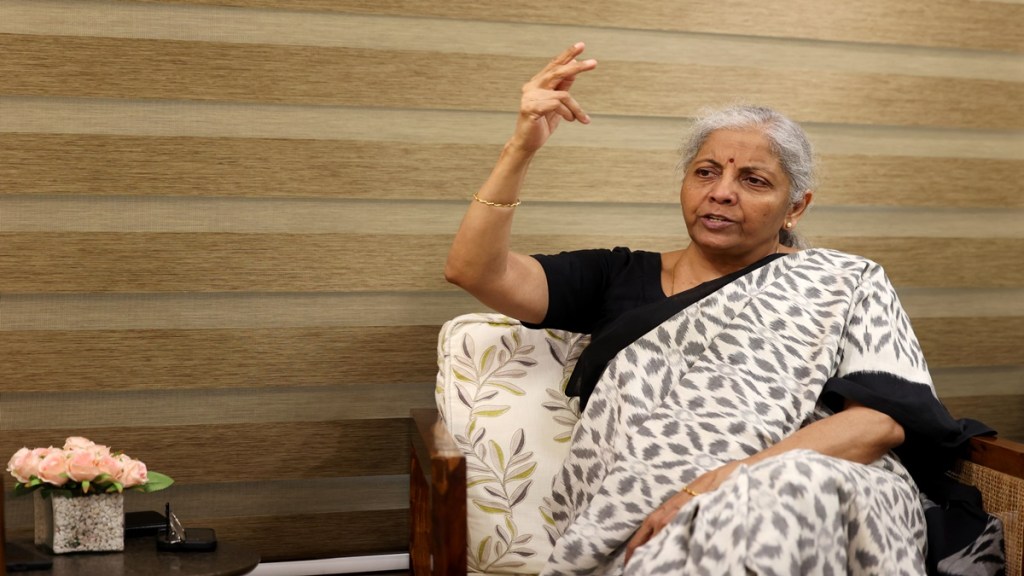As the deadline to avoid the United States’ punitive reciprocal tariffs is drawing closer, the government has hinted at uninhibited deal-making with the world’s largest economy, but also made an unequivocal commitment to draw definitive red lines in the best interests of India’s farmers and livestock breeders.
Reacting to President Donald Trump’s statement last week that an interim bilateral trade agreement (BTA) soon in the offing with New Delhi would “open up” the Indian market for America, finance minister Nirmala Sitharaman said: “Yes, we would love to have an agreement, a big, good, beautiful one; why not?”
In a free-wheeling interview with FE, the minister added: “At the junction we are in, and given our growth goals and ambition to be Viksit Bharat by 2047, the sooner we have such agreements with strong economies, the better they will serve us.”
According to the minister, agriculture and dairy have been among the “very big red lines,” where a high degree of caution has been exercised, during BTA talks with the US.
On a perceived slowdown in investments by the private sector, the minister said things have started changing for the better. “At least in the last six months, there is a clear sign that private investments and capacity expansion are happening… There is definitely surplus cash with private companies, and they’re probably earning passive income. But we can see signs of change”.
Asked what the government is planning to do to reverse urban slowdown, Sitharaman said, sentiment is definitely turning in urban areas too. “From April, there have clearly been signs of the (positive consumer) sentiment playing out (thanks to the income tax reliefs)”, she said.
Sitharaman outlined a raft of “second-generation reforms” to be unleashed soon to impart a structural push to the economy, including “getting the banks to be better off,” and spurring private investment in nuclear energy. She also indicated that the weighted average Goods and Services Tax (GST) might come down from the current levels, as part of a restructuring of the rates and slabs of the eight-year-old comprehensive indirect tax.
She stressed the need to give additional support to merchandise exports, while noting that tax content in exported products isn’t fully neutralised yet, with certain embedded state and local levies.
“We are looking at different dimension of reforms other than, of course, land and asset monetisation,” she said, while asserting that, “there is no going back on the three labour codes, which states are keenly taking up.”
Sitharaman, who met the chiefs of public sector banks on Friday for a performance review, acknowledged the issue of their deposits (CASA) not growing as much as they used to. “There will be some kind of attempt by the banks to improve on this,” she said, referring to the “tightrope walk” of bankers, as people at once want credit to become cheaper and deposits to yield better returns. “Though banks can go to the market to raise funds, CASA was a cheap capital available,” she noted, adding that challenge is compounded by the fact that retail savings are going to the stock markets at a greater pace.
She said the time has come for reaching a consensus at the GST Council to design a “very simplified and easy-to-comply” tax.
“The expectation is that (the average GST rate) will come down, and we are working on it. You can have the revenue buoyancy if the rates are low enough, and that leads to an expansion, which is a normal assumption in economics,” the minister said.
In many countries that adopted GST/VAT system over recent decades, the initial rates have been lower than in India, and some of them even managed to bring down the rates further, without taking any hit to revenues. The minister’s statement signals that, with buoyant GST revenues, the often-repeated demand for raising the average GST rate to the so-called revenue neutral rate (15%) was unlikely to be pursued, and rates could in general only reduce. That could provide a significant consumption booster to the economy.
The minister underlined the need for all states to improve investment climate further, and cautioned that, “otherwise investments which were coming to some parts of the country cannot reach other parts.”
Sitharaman said a major step taken for energy efficiency is the plan to have small, medium, small modular nuclear reactors. “India needs to ramp up its basic energy base itself,” she said, amid a renewed push to coal-based thermal power to meet the fast-growing peak power demand. “…solar and wind can always be the top-up.”
“The nuclear thing is getting wrapped up. The law will also have to be amended for it, which will happen sooner,” she said. According to sources, the government may move the amendments to the Atomic Energy Act and the Civil Liability for Nuclear Damage Act in the upcoming monsoon session to allow private investments in the construction and development of nuclear reactors.

